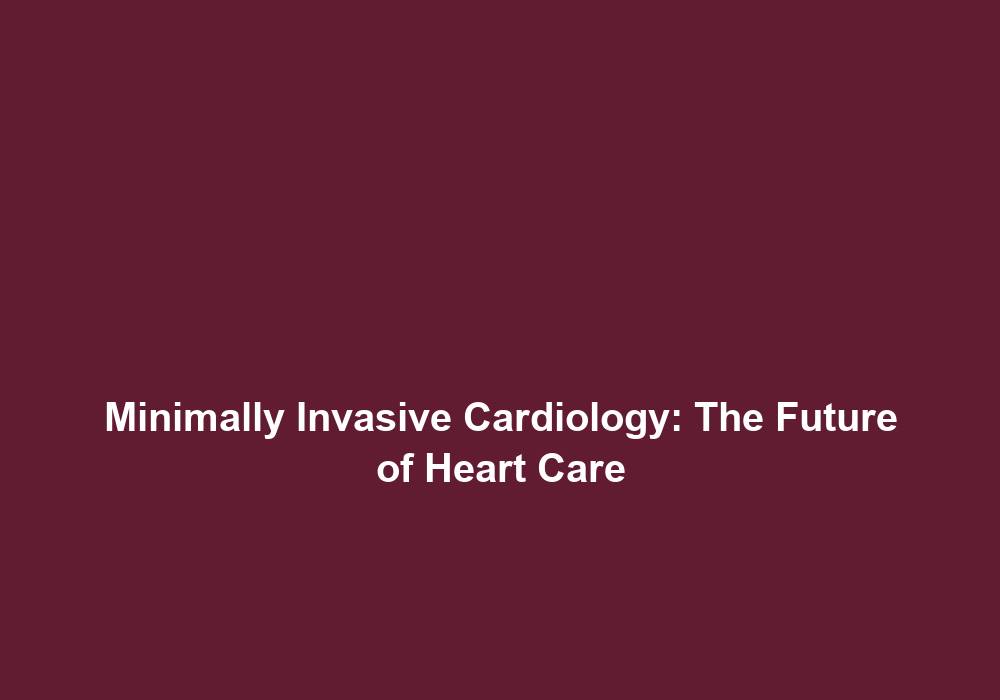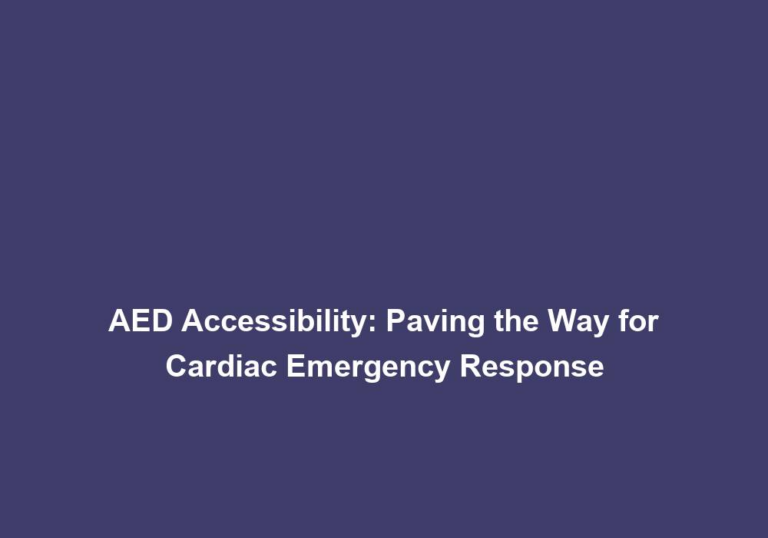Minimally Invasive Cardiology: The Future of Heart Care
With advancements in medical technology and surgical techniques, the field of cardiology has witnessed remarkable progress in recent years. One such groundbreaking development is the emergence of minimally invasive cardiology, which holds great promise for the future of heart care. In this article, we will explore the concept of minimally invasive cardiology, its advantages, and its potential impact on the field of cardiovascular medicine.
Understanding Minimally Invasive Cardiology
Minimally invasive cardiology refers to a specialized branch of cardiovascular medicine that employs cutting-edge techniques to diagnose and treat various heart conditions with minimal disruption to the body. Unlike traditional open-heart surgeries, minimally invasive procedures involve smaller incisions, reduced trauma, and faster recovery times.
Minimally invasive cardiology procedures utilize specialized tools and cameras to access the heart through small incisions. This eliminates the need for large incisions and sternotomy, reducing the overall invasiveness of the procedure. The use of smaller incisions leads to reduced blood loss, infections, and trauma to the patient, resulting in a lower risk of complications.
Benefits of Minimally Invasive Cardiology
The adoption of minimally invasive cardiology techniques has revolutionized the field of heart care in several ways. Here are some notable benefits:
-
Reduced Risk: Minimally invasive procedures generally carry a lower risk of complications compared to traditional open-heart surgeries. This is mainly due to the smaller incisions, which minimize blood loss, infections, and overall trauma to the patient.
-
Faster Recovery: Patients undergoing minimally invasive procedures experience shorter hospital stays and quicker recovery times. Since the incisions are smaller, there is less pain and scarring, allowing patients to resume their daily activities sooner.
-
Less Invasive: Minimally invasive techniques involve accessing the heart through small incisions using specialized tools and cameras. This eliminates the need for large incisions and sternotomy, which reduces the overall invasiveness of the procedure. Patients benefit from reduced trauma to the surrounding tissues and organs.
-
Improved Cosmetic Results: Smaller incisions result in minimal scarring, leading to improved cosmetic outcomes. This is particularly important for patients who may be concerned about visible scars after undergoing cardiac procedures.
-
Lower Healthcare Costs: Minimally invasive procedures can lead to cost savings in multiple ways. Shorter hospital stays, reduced medication requirements, and faster recovery times translate into lower healthcare expenses for patients and healthcare systems. Moreover, the reduced risk of complications also contributes to cost savings.
Applications of Minimally Invasive Cardiology
Minimally invasive cardiology techniques can be applied to a wide range of heart conditions, including:
- Coronary artery disease: Minimally invasive procedures, such as coronary angioplasty and stenting, are used to treat blocked or narrowed coronary arteries, restoring blood flow to the heart.
- Valvular heart disease: Transcatheter aortic valve replacement (TAVR) is a minimally invasive procedure that replaces a damaged or diseased aortic valve without open-heart surgery.
- Atrial fibrillation: Ablation procedures, utilizing catheters, are used to treat cardiac arrhythmias, such as atrial fibrillation, by destroying or isolating the abnormal electrical pathways causing the irregular heart rhythm.
- Congenital heart defects: Minimally invasive techniques can be employed to repair certain congenital heart defects, reducing the need for traditional open-heart surgeries.
- Cardiac arrhythmias: Ablation procedures are also used to treat other cardiac arrhythmias, restoring normal heart rhythm and alleviating symptoms.
Minimally Invasive Procedures in Cardiology
Let’s delve into some of the most commonly performed minimally invasive procedures in the field of cardiology:
1. Coronary Angioplasty and Stenting
Coronary angioplasty, also known as percutaneous coronary intervention (PCI), is a minimally invasive procedure used to treat blocked or narrowed coronary arteries. During the procedure, a catheter with a small balloon is inserted into the blocked artery and inflated to widen the narrow passage. In some cases, a stent is placed to keep the artery open, promoting better blood flow to the heart muscle.
2. Transcatheter Aortic Valve Replacement (TAVR)
TAVR is a revolutionary procedure used to replace a damaged or diseased aortic valve without open-heart surgery. This minimally invasive technique involves the insertion of a catheter, typically through the groin, and guided to the heart. A new valve is then delivered and positioned within the existing valve, restoring normal blood flow and improving overall heart function.
3. Ablation Procedures
Ablation procedures involve the use of catheters to treat cardiac arrhythmias, such as atrial fibrillation. High-frequency energy is delivered through the catheters to destroy or isolate the abnormal electrical pathways causing the irregular heart rhythm. This helps restore normal heart rhythm and alleviate symptoms.
These minimally invasive procedures offer significant advantages over traditional open-heart surgeries, including reduced risks, faster recovery times, and improved patient outcomes.
The Future of Minimally Invasive Cardiology
As technology continues to advance, the future of minimally invasive cardiology holds great promise. Here are some exciting developments on the horizon:
-
Robot-Assisted Surgeries: The integration of robotics into minimally invasive procedures allows for increased precision and control. Surgeons can remotely manipulate robotic arms to perform complex cardiac surgeries with enhanced accuracy, leading to improved patient outcomes.
-
Advanced Imaging Techniques: Advancements in imaging technology, such as 3D echocardiography and virtual reality, enable improved visualization of the heart during minimally invasive procedures. This enhances procedural planning, enables real-time monitoring, and increases overall success rates.
-
Nanotechnology: The use of nanotechnology in cardiology may enable targeted drug delivery, precise tissue repair, and improved diagnostics. These tiny particles can be engineered to specifically interact with cardiac tissues, enhancing treatment outcomes and potentially reducing side effects.
-
Bioengineered Tissue Replacement: Researchers are exploring the possibility of bioengineered heart valves and tissues, which can be implanted using minimally invasive techniques. This could revolutionize the treatment of valvular heart diseases and congenital defects, providing patients with more durable and biocompatible solutions.
In conclusion, minimally invasive cardiology represents the future of heart care. With its numerous benefits, including reduced risk, faster recovery, and improved cosmetic outcomes, it has the potential to transform the field of cardiovascular medicine. As technology continues to advance and new innovations emerge, the possibilities for minimally invasive procedures are endless. The future holds great promise for improving patient outcomes and revolutionizing the way we approach heart care.







